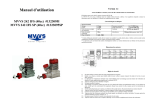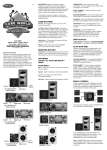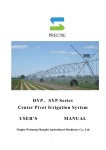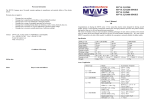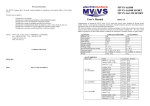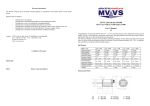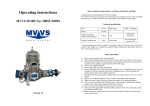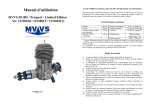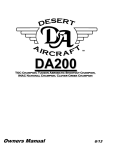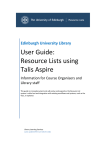Download Operating instructions
Transcript
Operating instructions MVVS 26 IFS MVVS 26 IFS SP č.: 3094IU č.: 3094SP Before using the engine, carefully read these instructions Congratulations on choosing the gas engine MVVS 26 ccm. MVVS 26 has been designed and manufactured for propeller-powered radio-controlled model planes. It is able to meet all of your expectations of an acrobatic racing engine. Technical specifications Bore Stroke Weight of complete engine without ignition* Weight of ignition unit 33 mm 30.1 mm 936 g Maximum power output ** Maximum torque ** Fuel 3.8 PS/9000 RpM 3.1Nm/8000 RpM Unleaded 95-octane fuel 165 g Lubrication Oil with petrol in mixture 1:40 RpM range 1400–9500 * The value in the table above stands for the weight of a completely assembled engine, including the spark plug, carburetor, drive washer and prop screws. ** Power output varies with the exhaust used. The value given in the table stands for the maximum available power output. Engine’s dimensions A mm 146 B mm 99 C mm 50 D mm 70 E mm 60 F mm 31 G mm 4,3 H mm M10x1 I mm 10 J mm 33 Safety precautions 1) 2) 3) Version 1.10 Never use the engine for any manned vehicles. When operating model planes, always follow the rules and laws in effect in your country. The manufacturer declines all responsibility for all damages arising from the operation of models and other appliances droved by MVVS engine. 4) Always use original spare parts. 5) Never tamper with the engine construction. 6) Before each flight check that all the propeller screws are tightened up and in good condition. If you use a spinner, check that it is tightened up, too. When mounting the spinner always follow the assembly instructions. 7) Before each flight check that all the propeller screws are tightened up and in good condition. If you use a spinner, check that it is tightened up, too. When mounting the spinner always follow the assembly instructions. 8) Before starting the engine always make sure that the model is safely fixed in place and cannot start moving. 9) Fuel is combustible and therefore must be kept in an enclosed container at a safe distance from the engine when it is running. 10) When preparing fuel carefully follow the manufacturer’s or dealer’s instructions. 11) Small objects must be kept at a safe distance from the engine when it is running. Never throw any objects towards the spinning propeller. 12) Be careful in choosing the location where you wish to start the engine. Avoid dusty or sandy areas. 13) Start the engine in well-ventilated areas only. Never start the engine indoors. 14) When starting the engine make sure that bystanders, especially children, are at a safe distance of at least 10 meters. 15) The engine power output makes it possible to fly big models. Mal-operation of such models may cause serious damage. Start using the MVVS 26 in model planes only after you have mastered operating smaller models. 16) Periodically check that the engine is firmly fixed to the engine mounts. Never start a loose engine! 17) Always use a balanced propeller! Always replace the propeller when damaged! 18) Make sure that no part of your body intersects the plane of the spinning propeller. 19) Always wear close-fitting, well-fastened clothes when starting or operating the running engine. Never wear loosely hanging clothes (ties, scarf, etc.). 20) Never try to stop the engine by any part of your body. 21) Always stop the engine either by turning off the ignition switch or by completely closing the carburetor throttle valve. Exhaust Use only factory-made exhausts pipes designed for this type of engine, preferably brand-name MVVS engines with which you also get the power output guaranteed. The manufacturer declines all responsibility for all engine damages arising from the use of improper exhaust systems. When mounting the exhaust follow the manufacturer’s instructions. Make sure to secure sufficient cooling of the exhaust. 3270 3266 compact, medium level of power output tuned pipe, with adaptor 3265 provides the highest power output, with the flat torque curve, useful for the model planes 3266 Selecting a suitable propeller It is usually the case that propellers of the same dimensions coming from different manufacturers are not the same. Oftentimes not even propellers of the same dimensions produced by a same manufacturer are not the same. The engine power is best utilized when the propeller dynamics curve and engine power curve (revolutions / power output) intersect in the area of the engine top power output. Unfortunately, no propeller manufacturer provides this information. Engine power output is also a variable quality. It depends above all on the silencer used and can considerably vary. The situation is further complicated by environmental parameters (temperature and atmospheric pressure in particular): low temperature and high pressure increase propellers’ input requirements by 20% in comparison with input at hot weather. MVVS 26 has been designed to generate maximum power at 8500 RpM, according to the type of exhaust used. If you wish to utilize the maximum power output, choose a propeller which allows the engine to reach these revolutions, or slightly lower revolutions (given the unloading of the propeller depending on the speed of flight) on the ground. We do not recommend using propellers with which the engine reaches more than 9000 RpM. on the ground. Suggested propeller dimensions: 16x8, 16x10, 16x11, 16x12, 17x8, 17x10, 17x 12, 18x8 3270 Carburetor adjustment Basic setting: adjusting needle ( L ) for low RpM range 1 turn and 50 minutes adjusting needle ( H ) for high RpM range 1 turn and 35 minutes (Minutes refer to hands of a clock) for WT 793 Walbro WT 793 Choke Fuel Always use unleaded 95-octane petrol mixed in the proportion 40 volume units of petrol to 1 unit of Mobil Racing 2T oil. If necessary, quality brand-name synthetic oil intended for racing two-stroke engines can be used too. Mix it in the proportion 30:1. Never use inexpensive oil developed for garden appliances or synthetic oils intended for the operation of methanol model engines. The manufacturer declines all responsibility for all engine damages arising from the use of low-quality fuel. Store fuel in containers designed for this purpose. Do not use mixed fuel older than 90 days. 3265 H needle adjusting screw L needle adjusting screw Lever - throttle Pressure pulse inlet Assembly Since air is used to cool the engine, sufficient air circulation under the cowl must be ensured. Never forget about a hot air outlet – which must be bigger than the intake. Gas engines heat up to a much greater degree than methanol ones! Do not forget that the engine needs oxygen from the air to be able to operate. Therefore ensure access of air to the engine intake as well. Caution: intake of warm air from beneath the cowl may cut the engine power output. Caution! When mounting the engine in the model use seals to protect all openings and prevent the pollution of the engine’s inside with sawdust, residual abrasives etc. The new engine comes adjusted to the basic setting. After the engine has been run in, adjust it following the instructions below: - start the engine and warm it up - let the engine run at idle speed for approx. 5 seconds Step I Accelerate to 2/3 of the throttle range within approx. 1 sec (faster acceleration). Repeat three times – if the engine accelerates quickly and without a hiccup go to Step III. If acceleration is not smooth go on to Step II. Step II Faulty acceleration with hiccups and a tendency to cut out is usually attributable to a poor fuel mixture in the medium-revolutions range. Stop the engine and recheck the fuel feed (the hose-pipe must not be pinched or broken; if fitted, check also the fuel filter permeability). Restart the engine and test acceleration again. If problems persist adjust the carburetor. Open the adjusting needle L by 5 min and retest acceleration. If acceleration is smooth, open the needle by another 3-5 min - this should be done because the needle was previously set at a boundary value; if atmospheric conditions changed during flight, the problems might recur. If the engine continues to not accelerate properly open the low speed needle by 10 minutes. If the engine’s operation does not improve, shut it off and check the basic setting. Set the adjusting needle L at 1 turn and 50 min and the adjusting needle H at 1 turn and 10 min., restart the engine and test the acceleration. If the engine runs correctly go to Step III. If it continues to not accelerate properly, open the low speed needle by another 10 minutes. If acceleration is faulty, the defect is likely to lie somewhere other than an adjustment. Step III If the engine accelerates correctly, according to the above test, set it at idle speed and accelerate to full speed. Repeat twice more. If the engine functions correctly, go to Step IV. If it cuts out, open the L needle by 5-10 minutes more. If the engine does not respond to acceleration fast enough, keep closing the L needle until the engine starts to cut out in response to throttle opening. At that point reopen the L nozzle by 5-10 minutes. maximum for a period of about one minute. At this point stop the engine and let it cool down. Then restart it and check the adjustment. If everything is all right, you can first take off. During first few flights do not overload the engine and do not let it run at high revolutions for long periods of time (very important at hot weather). Use up all fuel that was produced as a mixture with the oil (we recommend the MOBIL Racing 2T). From now on, fuel and oil should be mixed in the proportion 40:1. DO NOT PROCESS THE RUNNING-IN AT IDLE SPEED! You should get following results if the engine is settled up and in run correctly Engine 26 IFS Propeller APC 16/12 APC 16/10 Mejzlik 18/8 RpM 7300-7400 8100-8300 8100-8200 7200-7300 Silencer 3266 3266 3266 3270 These values are only approximate and may vary with the factors described in the previous section, as well as with the type of the exhaust system used. Possible faults of the engine and how to dispose those Step IV If the engine reacts correctly set it at full speed. If revolutions do not drop, the engine has been adjusted successfully. If revolutions seem to drop, open the adjusting needle H by about 5-10 minutes. Caution!!! The engine must be stopped while you adjust the carburetor in order to prevent injury by the propeller. Starting and running in a new engine Before you first start the engine, make sure that the plug is screwed in and tightened up and that the plug socket is fitted in place and fastened down properly. Fix the ignition sensor in proper position above the magnet with screws enclosed. Unless the spark plug is inserted in plug socket, never turn the engine with ignition turned on. This could lead to ignition damage! 1) Make sure that the ignition is switched off, the choke valve is closed and the throttle valve is about half opened. Then give the engine 3-4 turns, provided that carburetor is not overflowing. If it is overflowing, only give the engine 1-2 turns. 2) Switch the ignition on, close the choke valve, set the throttle at slightly higher idle speed and give the engine a few quickly turns. If even after the fourth turn, with the choke valve closed, you do not hear a suggestion of the engine starting, give the engine 2 turns following the instructions in paragraph 1 above. Then proceed according to instructions given in paragraph 2. 3) If the engine does not start even after another set of turns open the choke valve and the throttle to maximum and give the engine approx. 4 turns. Switch the ignition off and on again and restart the engine with throttle turned slightly down and the choke valve set open. 4) If the engine still would not start, unscrew the plug and check its contacts. Clean any possible petrol moisture (i.e. an indication of engine overflow) and screw it in again. Further starting should only be done with the throttle turned down. If the plug is dry then probably not enough fuel has been drawn into the carburetor. If that is the case, check the fuel feed and then return to the instructions given in paragraph 1. Having started the engine, leave it running for about 5 minutes at a higher idle speed. Then run it in for about 10 min, while changing revolutions from idle to 1/2-3/4 of the range and shortly holding each position - gradually prolong the holding periods. After 10 minutes of operation, open the throttle at If the engine does not start: check and possibly replace the spark plug (check the spark: put the plug into the cable end and by turning the engine you’ll see the necessary spark. Note: The plug must touch a metal part of the engine.) check fuel lines check for proper mechanical function by turning the engine over check that carburetor’s nozzles are adjusted correctly remove the carburetor cover from the feed side; check the filter and blow off carburetor with compressed air; (Caution: When using compressed air, use eye protection.) When re-assembling be careful of maintain the proper order of the components check the vacuum feed line Mechanical faults (if the engine can not be turned over easily) must always be handled by a professional service department Service suggestions After each 20 hours of running or 1 year change the spark plug. After 100 hours of operation time commit the engine to the professional service department for check-up. Re-assembling These operations are very complicated and it is not recommended to do it on your own. Please commit to professional service. Possible guide instructions we publish are as follows: Demount rear cover, head and carburetor. It is not possible to re-assemble the engine unless the cylinder part of the engine is heated up to 80° - 100°C. Then it is possible to remove steel piston insert without rotating (!). Next step is piston and connecting rod removal. Crankshaft has to be in the top dead centre (TDC). Pull off the connecting rod from pin on the crankshaft in direction to rear cover out of the crankcase. After getting off the drive washer and Woodruff (safety) key, it is possible to pull out the crankshaft again in direction to rear cover out of the crankcase. You will get the bearing out after heating up (again between 80°- 100°C). Assembling passes off in opposite meaning. Spare parts list Warranty The MVVS gas engines come with a three-year guarantee against defects in workmanship and materials. Only original buyers of the engines are eligible warranty claimants. The warranty cannot be transferred with a change in ownership. This guarantee does not cover: - any normal wear that might occur damage arising from accidents damage arising from the use of an unbalanced or damaged propeller damage arising from the use of a too small or a too big propeller damage arising from the use of low-quality fuel damage arising from the use of other than original spare parts and accessories damage arising from sucking a foreign object into the engine damage arising from any improper use Certificate of Warranty No: Description: N0101 Crankcase 0202 Front bearing 0203 Rear bearing I1101 Drive washer 1103 Propeller nut 0304 Pressure nipple 1104 Propeller washer 0306 Rear cover „O“ - ring 1106 Drive washer shim 0403 Sealing ring 3224 Walbro Carburetor 0404 Carburetor screw 1321 Carburetor flange 1310 Thermo-isolation washer 1305 Carburetor flange gasket (2pcs) 0502 Cylinder head screws - set 1307 Carburetor screws (2pcs) 0503 Cylinder head gasket 1308 Nuts (2pcs) 0601 Cylinder sleeve 1309 Nut’s washers (2pcs) 1405 Ignition sensor fixing screws 0701 Piston 0702 Piston ring 0801 Piston pin 0802 Piston pin circlips Buyer’s name and address: N1001 Crankshaft 1102 Drive washer key N0650 Cylinder-piston ass. Dealer: N0951 Connecting rod 0302 Rear cover screws - set I0501 Cylinder head Serial Number: No: Description: 0301 Rear cover N0501 Cylinder head 26 SP Date: 3314L Electronic ignition unit ICU-L 3309 Spark plug 3227D/26 Diffusor 26 SP Produced by: MVVS, spol. s r.o., tř. Kpt. Jaroše 35, 60200 Brno, Czech Republic Ph.: +420 545 211 683, fax: +420 545 211 418 E - Mail: [email protected] Http: www.mvvs.cz






